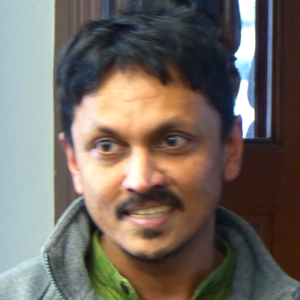Prof. Anand Yethiraj

LE STUDIUM Guest Research Fellow
From
Department of Physics and Physical Oceanography, University of Newfoundland - CA
In residence at
Molecular Biophysics Center (CBM) / CNRS - FR
Host scientist
Prof. Francesco Piazza
PROJECT
Macromolecular crowding: a physicist's perspective on understanding molecular motions in the complex environment of a living cell
The premise of this work is based on recent research that indicates that enzymes are physically propelled when they are catalyzing a reaction[1]. During the catalysis process, enzymes catalyze (i.e. greatly enhance the speed of) the transformation of “substrate” molecules into product species. Enzymes are seen to exhibit both chemotaxis and anti-chemotaxis[2], i.e., they exhibit motion either upward or downward, along or against the substrate concentration gradient. Follow-up work in groups in the USA[3], South Korea[4] and Spain[5] appear to confirm the observation, of enhanced motions, while other research suggests that this observation might simply be a fluorescence artifact[6]. We pursued (and continue to pursue) enzyme-nanoparticle attachment chemistry for multiple reasons:
- Using the nanoparticle as probe, we look for enhanced motions in the presence of substrate without fluorescence measurements, thus avoiding possible artifacts.
- The resulting functionalized nanoparticles would be “active nano-motors” that would have very fascinating non-equilibrium properties and would serve as an excellent model system for non-equilibrium soft matter.
- These active nanoparticles can serve as active crowders in mimics of the crowded cellular environment.
[1] Riedel, C., Gabizon, R., Wilson, C. A. M., Hamadani, K., Tsekouras, K., Marqusee, S. et al. (2015). The heat released during catalytic turnover enhances the diffusion of an enzyme. Nature, 517(7533), 227.
[2] Jee, A.-Y., Dutta, S., Cho, Y.-K., Tlusty, T., & Granick, S. (2018). Enzyme leaps fuel antichemotaxis. Proceedings of the National Academy of Sciences, 115(1), 14-18.
[3] Muddana, H. S., Sengupta, S., Mallouk, T. E., Sen, A., & Butler, P. J. (2010). Substrate catalysis enhances single-enzyme diffusion. Journal of the American Chemical Society, 132(7), 2110-2111.
[4] Jee, A.-Y., Cho, Y.-K., Granick, S., & Tlusty, T. (2018). Catalytic enzymes are active matter. Proceedings of the National Academy of Sciences, 115(46), E10812-E10821.
[5] Patiño, T., Feiner-Gracia, N., Arqué, X., Miguel-López, A., Jannasch, A., Stumpp, T. et al. (2018). Influence of enzyme quantity and distribution on the self-propulsion of non-Janus urease powered micromotors. Journal of the American Chemical Society.
[6] Günther, J.-P., Börsch, M., & Fischer, P. (2018). Diffusion measurements of swimming enzymes with fluorescence correlation spectroscopy. Accounts of chemical research, 51(9), 1911-1920.

